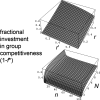The emergence of a superorganism through intergroup competition - PubMed (original) (raw)
Comparative Study
. 2007 Jun 5;104(23):9736-40.
doi: 10.1073/pnas.0703466104. Epub 2007 May 21.
Affiliations
- PMID: 17517608
- PMCID: PMC1887545
- DOI: 10.1073/pnas.0703466104
Comparative Study
The emergence of a superorganism through intergroup competition
H Kern Reeve et al. Proc Natl Acad Sci U S A. 2007.
Abstract
Surveys of insect societies have revealed four key, recurring organizational trends: (i) The most elaborated cooperation occurs in groups of relatives. (ii) Cooperation is typically more elaborate in species with large colony sizes than in species with small colony sizes, the latter exhibiting greater internal reproductive conflict and lesser morphological and behavioral specialization. (iii) Within a species, per capita brood output typically declines as colony size increases. (iv). The ecological factors of resource patchiness and intergroup competition are associated with the most elaborated cooperation. Predictions of all four patterns emerge elegantly from a game-theoretic model in which within-group tug-of-wars are nested within a between-group tug-of-war. In this individual selection model, individuals are faced with the problem of how to partition their energy between investment in intercolony competition versus investment in intracolony competition, i.e., internal tugs-of-war over shares of the resources gained through intergroup competition. An individual's evolutionarily stable investment in between-group competition (i.e., within-group cooperation) versus within-group competition is shown to increase as within-group relatedness increases, to decrease as group size increases (for a fixed number of competing groups), to increase as the number of competing groups in a patch increases, and to decrease as between-group relatedness increases. Moreover, if increasing patch richness increases both the number of individuals within a group and the number of competing groups, greater overall cooperation within larger groups will be observed. The model presents a simple way of determining quantitatively how intergroup conflict will propel a society forward along a "superorganism continuum."
Conflict of interest statement
The authors declare no conflict of interest.
Figures
Fig. 1.
The nested tug-of-war. Individuals engage in a selfish tug-of-war over resource shares within groups, and, simultaneously, groups engage in a tug-of-war with each other. The within-group tug-of-war reduces a group's ability to win the between-group tug-of-war.
Fig. 2.
Fractional investment in group competitiveness. (Upper) Individual's evolutionarily stable investment in group competitiveness (equals the degree of superorganismness) as a function of between group relatedness (r′) and within-group relatedness (r) (n = 100; n = 4; z = w). (Lower) Individual's evolutionarily stable investment in group competitiveness as a function of group size (n) and number of competing groups (N) (r′ = 0; r = 1/2; z = w).
Similar articles
- Asymmetry within social groups: division of labour and intergroup competition.
Barker JL, Loope KJ, Reeve HK. Barker JL, et al. J Evol Biol. 2016 Mar;29(3):560-71. doi: 10.1111/jeb.12805. Epub 2015 Dec 29. J Evol Biol. 2016. PMID: 26663312 Free PMC article. - The evolution of cooperation in asymmetric systems.
Wang R, Shi L. Wang R, et al. Sci China Life Sci. 2010 Jan;53(1):139-149. doi: 10.1007/s11427-010-0007-6. Epub 2010 Feb 12. Sci China Life Sci. 2010. PMID: 20596966 - Putting competition strategies into ideal free distribution models: habitat selection as a tug of war.
Flaxman SM, Reeve HK. Flaxman SM, et al. J Theor Biol. 2006 Dec 21;243(4):587-93. doi: 10.1016/j.jtbi.2006.07.012. Epub 2006 Jul 21. J Theor Biol. 2006. PMID: 16930625 - From inter-group conflict to inter-group cooperation: insights from social insects.
Rodrigues AMM, Barker JL, Robinson EJH. Rodrigues AMM, et al. Philos Trans R Soc Lond B Biol Sci. 2022 May 23;377(1851):20210466. doi: 10.1098/rstb.2021.0466. Epub 2022 Apr 4. Philos Trans R Soc Lond B Biol Sci. 2022. PMID: 35369743 Free PMC article. Review. - Testosterone as a mediator of the tradeoff between cooperation and competition in the context of cooperative reproductive behaviors.
Vernasco BJ, Moore IT. Vernasco BJ, et al. Gen Comp Endocrinol. 2020 Mar 1;288:113369. doi: 10.1016/j.ygcen.2019.113369. Epub 2019 Dec 16. Gen Comp Endocrinol. 2020. PMID: 31857075 Review.
Cited by
- Lifetime trajectories of male mating effort under reproductive conflict in a cooperatively breeding mammal.
Birch G, Nichols HJ, Mwanguhya F, Thompson FJ, Cant MA, Blount JD. Birch G, et al. Proc Biol Sci. 2024 Sep;291(2031):20241499. doi: 10.1098/rspb.2024.1499. Epub 2024 Sep 18. Proc Biol Sci. 2024. PMID: 39288806 Free PMC article. - The nasty neighbor effect in humans.
Romano A, Gross J, De Dreu CKW. Romano A, et al. Sci Adv. 2024 Jun 28;10(26):eadm7968. doi: 10.1126/sciadv.adm7968. Epub 2024 Jun 26. Sci Adv. 2024. PMID: 38924403 Free PMC article. - A colony-level optimization model provides a potential mechanism for the evolution of novel castes in eusocial ant colonies.
Nag S, Bhat AS. Nag S, et al. Heliyon. 2022 Jul 4;8(7):e09882. doi: 10.1016/j.heliyon.2022.e09882. eCollection 2022 Jul. Heliyon. 2022. PMID: 35815139 Free PMC article. - The exposome paradigm to predict environmental health in terms of systemic homeostasis and resource balance based on NMR data science.
Kikuchi J, Yamada S. Kikuchi J, et al. RSC Adv. 2021 Sep 13;11(48):30426-30447. doi: 10.1039/d1ra03008f. eCollection 2021 Sep 6. RSC Adv. 2021. PMID: 35480260 Free PMC article. Review. - Intergroup conflict: origins, dynamics and consequences across taxa.
De Dreu CKW, Triki Z. De Dreu CKW, et al. Philos Trans R Soc Lond B Biol Sci. 2022 May 23;377(1851):20210134. doi: 10.1098/rstb.2021.0134. Epub 2022 Apr 4. Philos Trans R Soc Lond B Biol Sci. 2022. PMID: 35369751 Free PMC article.
References
- Dugatkin L, Reeve HK. Adv Study Behav. 1994;23:101–133.
- Reeve HK. Evol Hum Behav. 2000;21:65–72.
- Hamilton WD. J Theor Biol. 1964;7:1–52. - PubMed
Publication types
MeSH terms
LinkOut - more resources
Full Text Sources

